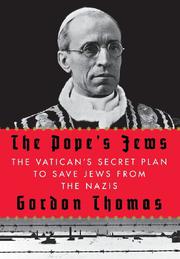by
Gordon Thomas
Growing up, I always had the impression that Pope Pius XII did all he could during World War II to help the Jewish people to escape from Hitler's plans to eliminate them. Probably the 1 think that solidified that fact for me was the 1983 TV movie, The Scarlet & the Black based on the book Scarlet Pimpernel of the Vatican by J.P. Gallagher*. It was the story of Monsignor Hugh O'Flaherty & what he did during WW II in the Vatican underground.
What I didn't know at the time, was that an effort had long been underway to destroy Pope Pius' reputation. It began, naturally enough in the Soviet Union. The campaign was known as Operation Seat 12. Articles were written in Pravda, as well as other papers. There were stories being reported on radio & television stations across the world. Of course there was no mention of the communist source for many, if not most of the stories.
Then came the 1963 play, The Deputy, by Rolf Holchuth. It portrayed Pius as a financially greedy Pope silent about the Holocaust. There have been several possible sources suggested for the play.
In 2007, a high ranking intelligence officer who had defected during the Cold War, Ion Mihai Pacepa said that the outline for the play had been done by KGB General Ivan Agayants. The research was supplied by KGB agents. The plausability of this story is helped by the fact that the play's producer, Erwin Piscator had ties to the USSR.
Another possible source was Bishop Alois Hudal. I won't go into detail about him here as he does play a large part in the true story. All I will say is that he was a huge Nazi sympathiser who often worked to undermine the Pope during war. After the war he helped many Nazis, like Klaus Barbie & Adolph Eichman escape. He was dismissed from his post & remained bitter until his dying day, writing many attacks on Pius XII.
I must make it clear that neither of these possibilities is definite. I share them to show the possible motives for writing the play to attack Pius XII.
Many other attacks, verbal & written have come out since. But there have been many people speaking & writing to defend Pius XII & show the truth of what really happened.
This book is 1 of the latest to do so.
The book begins on 10 February 1939 with the death of Pope Pius XI. It looks at the events that took place up to & including the election Of Eugenio Pacelli as Pope Pius XII. In this chapter we also meet many of the key players in the book. They include Sir Robert D"Arcy Osborne, British Minister to the Holy See; John May, Osborne's Butler; Ugo Foa, president of the Jewish community in Rome; Israel Zolli, the chief rabbi of Rome; & the previously mentioned Monsignor O'Flaherty.
The chapter ends with a mention of Pope Pius XII"s speech to a group of family & close friends that included the Jews he had found sanctuary for in the Vatican. His theme was a passage from
Mitt Brennender Sorge, the encyclical he had helped write for Pius XI. That encyclical was a condemnation of Nazi doctrines that went against Catholicism as well as the racial policy that exalted 1 race over another. It was from that part of the encyclical that he quoted.
Pius then began to write his 1st encyclical,
Summi Pontificatus. In it he attacked racism & anti-semitism. As the book points out, the leadership in Berlin saw it as a clear cut warning of where the Pope stood when it came to their treatment of the Jews, he would work to oppose it.
Having set the stage, the book now goes on to look at what happened over the next few years in & outside the Vatican. Often times he quotes writings, like journals & diaries, by individuals about what they experienced. This gives the book a feeling like you are there.
In fact I will admit that I had a hard time dragging myself away from reading it when I had to put it aside for something else. That is how riviting I found it. The book could be described as part thriller, part mystery, part action-adventure, part spy story & part tragedy.
The tragedy part includes the story of how Rabbi Zolli saw what lay ahead. Foa & the other leadership rejected his warning to leave before what was happening elsewhere happened in Rome. Of the 1007 shipped to Auschwitz, all but 196 were gassed within hours of their arrival. Only 17 survived to the end of the war. After the war Foa said he had no regrets for what he did. He came across a bit hypocritical to me. He condemned Zelli for abandoning the community to hide out while not only hiding himself, but actually leaving Rome. & that is only 1 example oh how Foa et al worked to undermine Zolli's attempts to protect the community he was spiritual leader of.
Thomas shows us not only the good Pius did, working behind the scenes, as well as speaking out. He was NOT silent as his attackers claim. We see how vocal he really was & why Hitler wanted to kidnap him. In showing us what all Pope Pius did & said we also see that the Pope was anything but aloof to what was going on with the Jews in Rome & elsewhere.
Thomas doesn't cover up the wrong decisions Pope Pius made. He did make a few. But then everyone does. Papal infallibility doesn't extend to every decision a pope makes. In retrospect it is easy to see that he could have made some different decisions. The reality is, Pope Pius tried to do what was he felt was best for all, Catholic or Jew.
Thomas tells us what happens to most of the people after the war ended. There was 1 disappointment for me, he failed to say what became of Monsignor Enrico Pucci. Pucci was something of a major gossip monger, before & during the the war. He was also a fascist who gave information to the Italian Secret Police. It would have been nice to know what happenned to him after makig several appearances in the 1st part of the book.
I know that you can't cover everything in 1 book. But the author does give us a good overview of what really happened. & it does show that Pope Pius was not the villain that his enemies paint him as.
This book was very well researched. Thomas had many insiders within the Vatican to help him. He & his research team did many interviews of those who were still around. In addition, there are all the writings he used as well.
One of those who helped him was Sister Margherita Marchione. More than anyone else, she has striven to get the truth out. In doing so she has come under attack herself.
This book goes far in getting the facts out. But, IMHO, for some people not even a dozen or more smoking guns would convince them. Their minds are made up & they don't want to be confused by the facts. Because of the 75 year rule of secrecy, most of the wartime documents won't be released from their repository in L'Archivio Segreto Vaticano until 2020. Pope Benedict XVI could order an early release. Whenever they are released, it will end the controversy for most people. & silence most of them. But as I already pointed out, there will still be a few very vocal naysayers.
In the meantime, it is nice to see one more voice speaking up to get the truth out.
______________
*I recommend reading this book as well. It goes into much greater detail than the movie ever did. the book is available from Ignatius Press under the title of the movie.










0 Comments:
Post a Comment
Subscribe to Post Comments [Atom]
<< Home